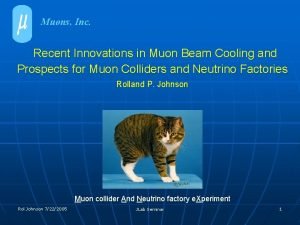Neutrons and Muons and Cosmic Rays Oh My

- Slides: 1

Neutrons, and Muons, and Cosmic Rays, Oh My! π μ Day 1: I Wish They All Could Be Californium… Objective: Determine the position of a neutron source (Californium – 252) along a single Mo. NA scintillating bar using the charge and time difference as determined from a digital oscilloscope. Ryan, Jamie, and Brandi 0 π Methodology: When a neutron passes through a scintillator bar, it collides with a proton in the material, creating photons, which travel to the ends of the bar and are detected by a photomultiplier tube (PMT) on both ends of the bar. This signal is then transmitted through two different leads to two separate channels on the oscilloscope. The time difference between the two peaks displayed on the oscilloscope was measured for twelve trials at five distances from the left PMT: 0. 0 in, 17. 5 in, 35 in, 52. 5 in, and 70 in. In addition to the time difference, the maximum voltage of each peak was also recorded, in order to calculate the Center of Gravity (COG), which is the ratio of the voltage difference between the two peaks divided by the additive sum of the two peaks. νμ + π Calibration plots were generated for the time difference vs. distance and for the COG vs. distance. A linear regression was used to find the equation of the line. The neutron source was then moved to an undisclosed location, and again twelve measurements were taken. The average value for both the time difference and the COG were calculated, and the equation from the linear regression was used to determine the position of the neutron source along the scintillating bar. 15, 00 Conclusions: Average Time Interval vs. Position Along One Scintillating Bar 10, 00 5, 00 0, 00 γ 0 10 20 30 40 50 60 70 80 -5, 00 -10, 00 R 2 = 0, 8446 -15, 00 γ The Bosons: Ryan Batkie, Jamie Benigna, and Brandi Bryan Day 2: Where, Oh Where Can the Neutrons Be? Objective: + μ Locate where along one of the Mo. NA’s scintillating bars the Californium-248 neutron source (pictured to the left) has been placed. A calibration plot was prepared by setting the neutron source at 21. 59 cm, 100 cm, and 184. 15 cm from the left photomultiplier tube (PMT). e + e e -20, 00 Day 3: Fly Me to the Muons, and Let My Ray Come from the Stars Objective: Determine the angular distribution for cosmic ray muons as they pass through one vertical stack of eight scintillating bars in Mo. NA. Methodology: Using the NSCL Data Acquisition System (DAQ), thousands of measurements can be taken within a minute. Histograms were generated for Time Difference (upper left), Charge Difference (upper right), and Center of Gravity (lower left). Mean values were extracted from the histograms (displayed to the left) at each standard distance (21. 59, 100. 00, and 184. 15 cm). The mean was determined by zooming in on the peak and changing the binning of the x-axis to get greater resolution. As a check, the Integrate feature of the Spec. Tcl computer program was used to fit a Gaussian curve to each of the displayed windows to calculate the mean and values used to calculate the error (Full Width at Half Maximum and the integrative Area). The error was calculated by dividing the FWHM by the square root of the integrative Area. Linear regressions were generated for the eyeball values and for the values determined by the computerized Gaussian fit. Once the neutron source was moved to an unknown location, Time Difference, Charge Difference, and Center of Gravity plots were analyzed for the unknown position. 10 5 0 0 50 -5 -10 R 2 = 0, 9996 -15 100 150 Methodology: Data was collected with Mo. NA for 16 hours. The data was filtered for rays that travelled only through the A stack of Mo. NA bars. Due to the height and width of the Mo. NA stack, no muons can enter beyond an incidence angle of ± 70˚. The software automatically determines the difference in the x coordinate from where the muon enters the top bar to where it exits the bottom bar. This is displayed in the adjacent lefthand graph. + e In order to determine the muon velocity, the time difference between the top and bottom bars was also measured. This distribution is displayed in the righthand graph. To determine the average muon velocity as it passes through the Mo. NA stack, it is assumed that the most common time corresponds to the most common angle, which is 0˚. Dividing the height of the stack by this most common time, gives the velocity of a vertically traveling muon. Conclusions: Incidence Angle Distribution The distribution to the left demonstrates that high angle incidence for muons is rare. This is logical given the two hurdles that muons must overcome to reach Mo. NA: 1. the Earth’s magnetic field deflect muons away from Earth if they approach at large angles, and 2. the atmosphere causes a cosmic ray shower, so only the muons that approach perpedicular to the Earth’s surface will reach Mo. NA before decaying – muons that approach at large angles have too much atmosphere through which to travel and are more likely to decay before reaching the surface. Conclusions: Time Interval vs. Dist to Left PMT 200 While all of the calibration plots had high R 2 values (>0. 991), the time difference data gave histograms with more symmetrical and narrower peaks, so this data was used to generate the calibration plot (pictured to the left). Using the eyeball time difference plot, we calculated the position of the source to be 78. 7 cm from the left PMT. The actual position was 76. 2 cm, resulting in a 3. 2% error. All calibration plots generated a value for the unknown location of the source that was too far to the right. A possible explanation for this might be that the source was too far to the left when it was set at the 100 cm point. The data collected from the oscilloscope were wildly variant, with standard deviations well beyond the mean values calculated. The large fluxion is likely due to background interference and a small sample size (12 data points per distance). After looking at both the time interval and center of gravity data, we took an average of all calculated values of the unknown position of the Californium neutron source, and we predicted a location of 22. 5 inches from the left photomultiplier tube. The actual location was 20 inches from the left edge, resulting in a 12. 5% error. To get a better linear regression, data from the 0 inch mark was omitted. -80 -60 -40 -20 0 20 40 60 80 The speed of the muons was determined to be 93% the speed of light. This makes the muon a relativistic particle: time and length are contracted. The NSCL is funded in part by the National Science Foundation and Michigan State University.

